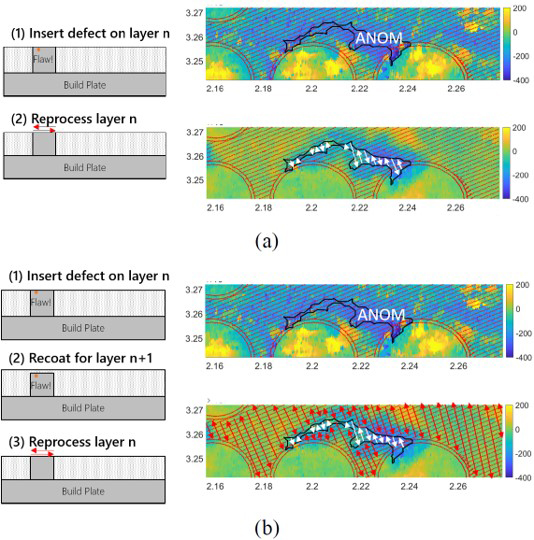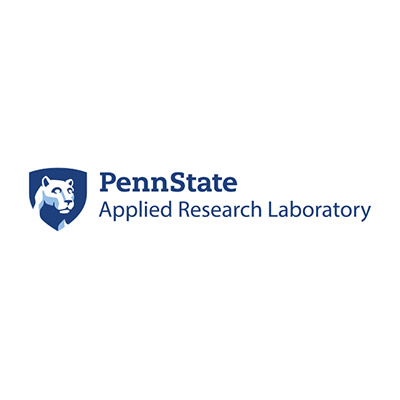


(a) Intra- and (b) inter-layer defect mitigation (defect mitigation vectors generated by modeling software are shown in white).
Problem
Both the promise and difficulty of laser-based powder bed fusion additive manufacturing (LPBF) lie in its ability to produce arbitrarily complex components by sequential melting of tracks and layers via a high-intensity beam. The advantages of producing novel and high-value components with an automated, sequential process are clear and account for the rapid adoption of LPBF. During deposition of each individual laser track, however, there is a non-zero probability for the formation of defects, partly due to complex laser-material interactions in and around the melt. This propensity for flaw formation presents a major challenge for the production, inspection, and qualification of high-value components.
Objective
The objective of this work was to develop and demonstrate methods to mitigate LPBF defects via intra-layer and inter-layer control. The proposed work leveraged the ability to insert surrogate defects (representative of naturally occurring lack of fusion and porosity) at known locations with an accuracy on the order of 60 μm. The focus of the effort was on the development and testing of methods to correct known defects by assuaging real-time perturbations and reprocessing select areas on an intra- and inter-layer basis.
Technical Approach
Defect mitigation methods were demonstrated on a commercial 3D Systems ProX-320 LPBF system located at the Center for Innovative Materials Processes through Direct Digital Deposition (CIMP-3D), operated by the Pennsylvania State University’s Applied Research Laboratory (Penn State ARL). Surrogate flaw formation was based on Penn State ARL’s FPGA-based data acquisition sensing and control (DAQ-SC) system. Intra- and inter-layer mitigation used the 3DS API for path-plan input and modification together with the DAQ-SC system. To direct mitigation actions, Applied Optimization leveraged their AMP process modeling and FSP software. The efficacy of developed methods was assessed via X-ray computed tomography (CT) scans and metallography.
The intra-layer corrective action was applied to remelt the surrogate defect locations (denoted as anomalous or ANOM) after a layer is scanned, but before the powder recoat was applied. This corrective action inserted track vectors only at ANOM locations. The inter-layer corrective action was applied by modifying the scan parameters and scan path at the ANOM locations in the following layer. In both cases, defect mitigation was applied on a near-real-time basis. The focus of the effort was on development and testing of methods to correct known ANOM locations via model-driven reprocessing of areas containing known defects.
Accomplishments
Three mitigation techniques were generated, each of which could be applied on an intra- and inter-layer. Mitigation of defects generated through seeded process anomalies during a laser-based powder bed fusion process of Ti-6Al-4V using base OEM parameters was most successful when performed on an intra-layer basis. The improved performance of intra-layer mitigation over inter-layer mitigation provides insight into mitigation strategies during real processing conditions. Intra-layer mitigation would suggest providing corrective measures on the same layer where a process anomaly is detected and to continue mitigating on each layer until the anomaly is no longer detected. Moreover, intra-layer mitigation implies applying corrective measures on a sequence of layers rather than a single layer following the detection of the anomaly (inter-layer mitigation). This effort benchmarked and identified effective defect mitigation techniques and parameters based on defect metrics. Currently, the work presented in this report is being adapted for a journal publication with the working title “Assessment of in-situ defect mitigation strategies in metal laser powder bed fusion additive manufacturing.” The manuscript outlines the mitigation methods developed under this program and their impact on reducing internal defects.
Project Participants
Project Principal

Other Project Participants
- Applied Optimization, Inc.
- 3D Systems Corporation
- ASTM International
Public Participants
- U.S. Department of Defense
